(Def. gan·grene: localized death and decomposition of body tissue, resulting from either obstructed circulation or bacterial infection)
A tooth is a wonder of nature. Its birth is so unique and complex that no one can really understand it in its entirety. It is the only organ in the body made up of three embryonic layers. The endoderm, which develops into the brain, the mesoderm, which develops into blood, bone, and muscles, and ectoderm, which develops into the skin, nails, and hair.
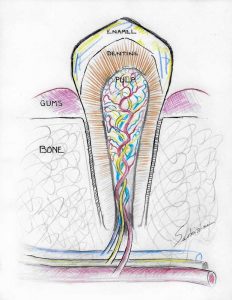 Every tooth has a canal going through its center containing live tissue that brings nerve fibers, cells and nutrients through tiny blood capillaries into its core. This tissue is collectively called the pulp. In teeth that just erupt, the canal space which accommodates the pulp is huge and has a rich blood supply. (Click on images to enlarge)
Every tooth has a canal going through its center containing live tissue that brings nerve fibers, cells and nutrients through tiny blood capillaries into its core. This tissue is collectively called the pulp. In teeth that just erupt, the canal space which accommodates the pulp is huge and has a rich blood supply. (Click on images to enlarge)
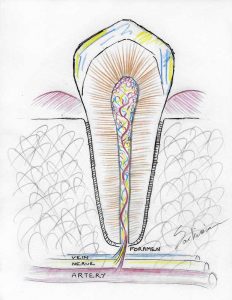 The root tip at this stage is still not formed and continues to calcify over the next few years.
The root tip at this stage is still not formed and continues to calcify over the next few years.
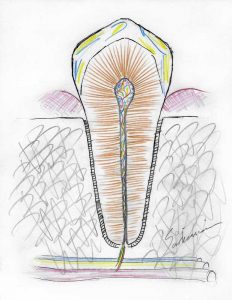 In a young adult, the canal space has shrunk but is still capable of providing nutrition to the whole tooth.
In a young adult, the canal space has shrunk but is still capable of providing nutrition to the whole tooth.
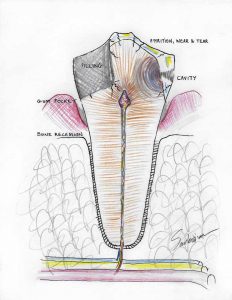 The canal gets narrower and narrower due to aging, continuous use, cavities, dental treatment, bruxism, and trauma. This occurs as cells lining the canal walls deposit dentin substance along the inside walls, thus constricting the space available for the pulp. Due to its confined space, inflammation or infection within the pulp does not heal as would, say, a similar bruise or infection in your skin or muscle tissue.
The canal gets narrower and narrower due to aging, continuous use, cavities, dental treatment, bruxism, and trauma. This occurs as cells lining the canal walls deposit dentin substance along the inside walls, thus constricting the space available for the pulp. Due to its confined space, inflammation or infection within the pulp does not heal as would, say, a similar bruise or infection in your skin or muscle tissue.
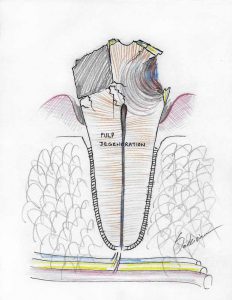 The damaged cells and their toxins simply cannot be evacuated fast enough, and the limited blood supply through the tiny opening under the root tip would not be sufficient to heal damage. The tooth subsequently goes through a phase of pain (not necessarily) and the pulp degenerates.
The damaged cells and their toxins simply cannot be evacuated fast enough, and the limited blood supply through the tiny opening under the root tip would not be sufficient to heal damage. The tooth subsequently goes through a phase of pain (not necessarily) and the pulp degenerates.
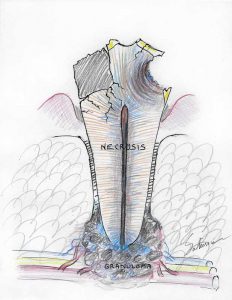 This is essentially a micro-gangrene within the tooth. The dead tissue decomposes and becomes infected by bacteria which grow unchecked, enter the millions of tiny tubules along the canal walls,
This is essentially a micro-gangrene within the tooth. The dead tissue decomposes and becomes infected by bacteria which grow unchecked, enter the millions of tiny tubules along the canal walls, 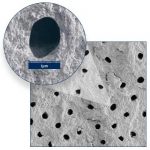 until they and their toxins spill out into the bone surrounding the root. This is called a granuloma and is now visible in an Xray as a dark shadow surrounding the root.
until they and their toxins spill out into the bone surrounding the root. This is called a granuloma and is now visible in an Xray as a dark shadow surrounding the root.
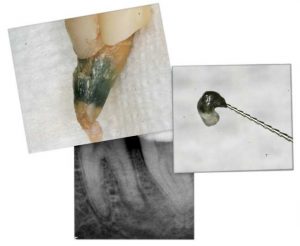 This process may occur with or without pain. If it has not prompted a person to seek dental treatment, it may only be a chance discovery in an Xray.
This process may occur with or without pain. If it has not prompted a person to seek dental treatment, it may only be a chance discovery in an Xray.
In the absence of pain, the patient will be surprised when he/she is told that he/she will need a root canal. A granuloma is a focus of infection for the body. Toxins emanating from it will travel to the heart lining, the kidneys, and the joints, and contribute to disease. The immune system will be working overtime to counteract the damages it is causing.
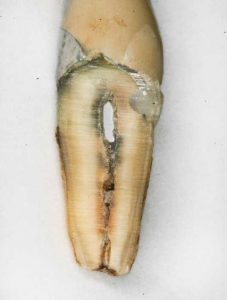
Sometimes pain can be helpful by sounding the alarm. If the alarm is absent, the chronic infection will cause more damage and will grow unchecked, eating away at the bone and creating a huge void, or a “hole” which one day WILL turn into an abscess. At that point, it will be too late to save the tooth. (An extracted root canalled tooth was ground down to show its cross section through the canal, revealing the amount of dead and decomposing tissue around the root canal filler.)
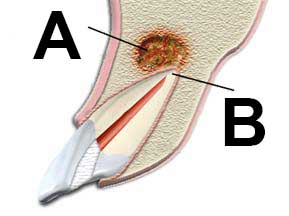 The second reason to address these granulomas immediately is that the larger the bone void is, the harder it is to heal and rebuild new bone. Therefore if the tooth were extracted, there will be a large defect along with insufficient bone in case an implant were to be placed. (A-Abscess not healed; B-Untreated, failed root canal)
The second reason to address these granulomas immediately is that the larger the bone void is, the harder it is to heal and rebuild new bone. Therefore if the tooth were extracted, there will be a large defect along with insufficient bone in case an implant were to be placed. (A-Abscess not healed; B-Untreated, failed root canal)
Granulomas also remain in teeth with an old root canal. These only need to be observed if they are very small, but generally, they are not desired for the same reasons. It may indicate failure of the root canal, remnants of toxic tissue inside canals, a crack in the root, or simply that the body cannot handle the dead tooth. In such cases, extraction may be a better option. Once the tooth is extracted, the bone is cleaned out, and a graft is placed to preserve bone for a future implant.
Our first choice for a restoration is a metal-free zirconia implant, which has excellent biocompatibility. Click on the image below to see the extraction option and subsequent restoration with a zirconia implant.
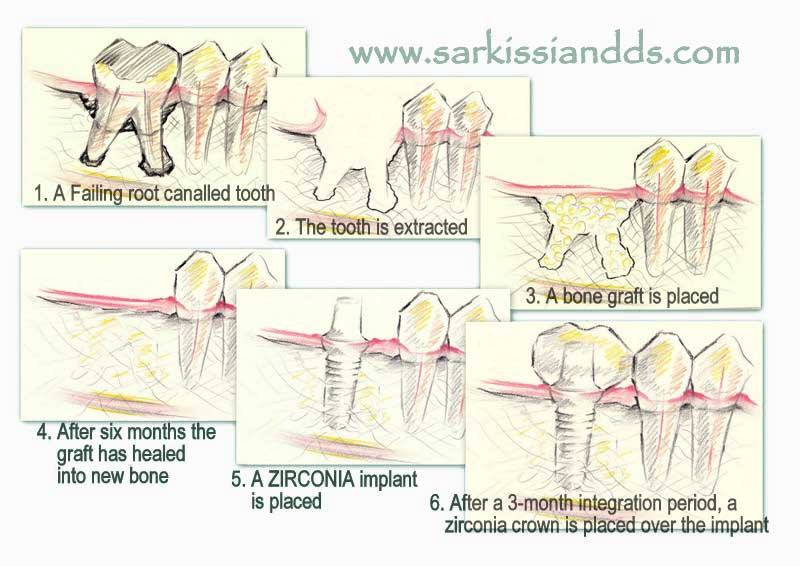 If a tooth is opted to be saved, a root canal procedure has to be performed. For a series of illustrations explaining the root canal procedure, see the article Root Canal Treatment – The Last Resort
If a tooth is opted to be saved, a root canal procedure has to be performed. For a series of illustrations explaining the root canal procedure, see the article Root Canal Treatment – The Last Resort
Doing nothing is not an option for dead teeth. In any other field of medicine, a dead or gangrenous tissue or organ would immediately be removed. Many people nowadays are opposed to root canals, for various reasons, and avoid the procedure. However, keeping a dead tooth in the body and avoiding a root canal is also a misconception that may have grave consequences. If a tooth is dead or gangrenous, the ONLY other option left, if a root canal is not desired, is extraction.

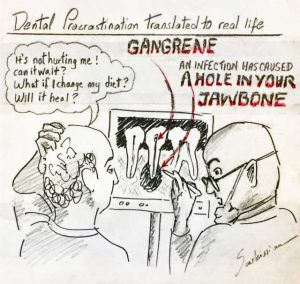
My tooth is in pain pls help me
That is – unfortunately – not quite possible over the internet – – – – yet.